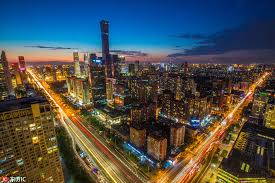Resilience seen in Chinese November growth data

Beijing: The Chinese economy performed better than expected last month, pointing to growth resilience and good signs for economic conditions in December and January, officials and analysts said on Monday.
Industrial output expanded by 6.2 percent year-on-year in November, up from 4.7 percent for October. Retail sales growth rose to a five-month high of 8 percent year-on-year, versus 7.2 percent a month earlier, the National Bureau of Statistics, China Economic Net reported.
“The economy sustained the momentum of progress in overall stability,” said NBS spokesman Fu Linghui.
“This reflects great resilience, potential and room to maneuver for the Chinese economy amid complicated external conditions,” Fu said.
November’s Singles’ Day shopping festival continued to be an important driver of online sales, he said, adding that online sales contributed about 0.9 percentage point to retail sales growth.
Accelerating economic activity has consolidated the basis of achieving this year’s annual growth target of 6 to 6.5 percent, he said.
In the short term, the Chinese economy faces less uncertainty from external demand, given progress toward resolving Sino-US trade friction and a stabilizing global manufacturing sector, according to a report released by China International Capital Corp.
This, in tandem with domestic policy efforts to stabilize growth and the resilience of demand for real estate, may keep economic activities recovering until the Spring Festival holiday season, which starts on Jan 24, it said.
“Given the pattern of China’s economic cycle, economic growth may stabilize and even pick up in 2020, predicated on continuous improvements in the domestic business environment and external demand,” said Yang Weiyong, an associate professor of economics at the University of International Business and Economics in Beijing.
But Yang said downside risks should be monitored, citing the complexity of the trade friction with the US. “Policymakers should focus on fostering a pro-business environment featuring fair competition and respect for property rights.”
Fu, the NBS spokesman, also said slower global growth and domestic economic restructuring may weigh on the economy in the next year, making it necessary to deploy growth stabilization policy efforts.
Ensuring steady growth does not necessarily mean fixating on GDP growth of no lower than 6 percent, often seen as a psychological threshold, he said. “As long as economic development complies with requirements of the (high-quality) phase, I think either slightly quicker or slower growth will be acceptable.”
Fu said China’s economic development in 2020 should be aimed more at qualitative targets such as higher quality and efficiency of development, increases in people’s income and environmental improvements.
Economic upgrading continued in November as the output of high-tech manufacturing and equipment manufacturing grew by 8.9 percent and 8.5 percent, respectively, outperforming total industrial output, the NBS said.
Fixed-asset investment expanded by 5.2 percent in the first 11 months, unchanged from the January-October period. The surveyed urban jobless rate stood at 5.1 percent, the same as in October.
Liu Chunsheng, an associate professor of international trade at the Central University of Finance and Economics, said good news from Sino-US trade talks, the effects of counter-cyclical policies and the Singles’ Day shopping festival were key factors leading to better economic performance last month.
To achieve steady, quality growth in 2020, it is critical for China to continue vitalizing the private sector by easing financing woes, putting tax and fee cut measures into place and aiding in the exploration of new export markets, Liu said.





